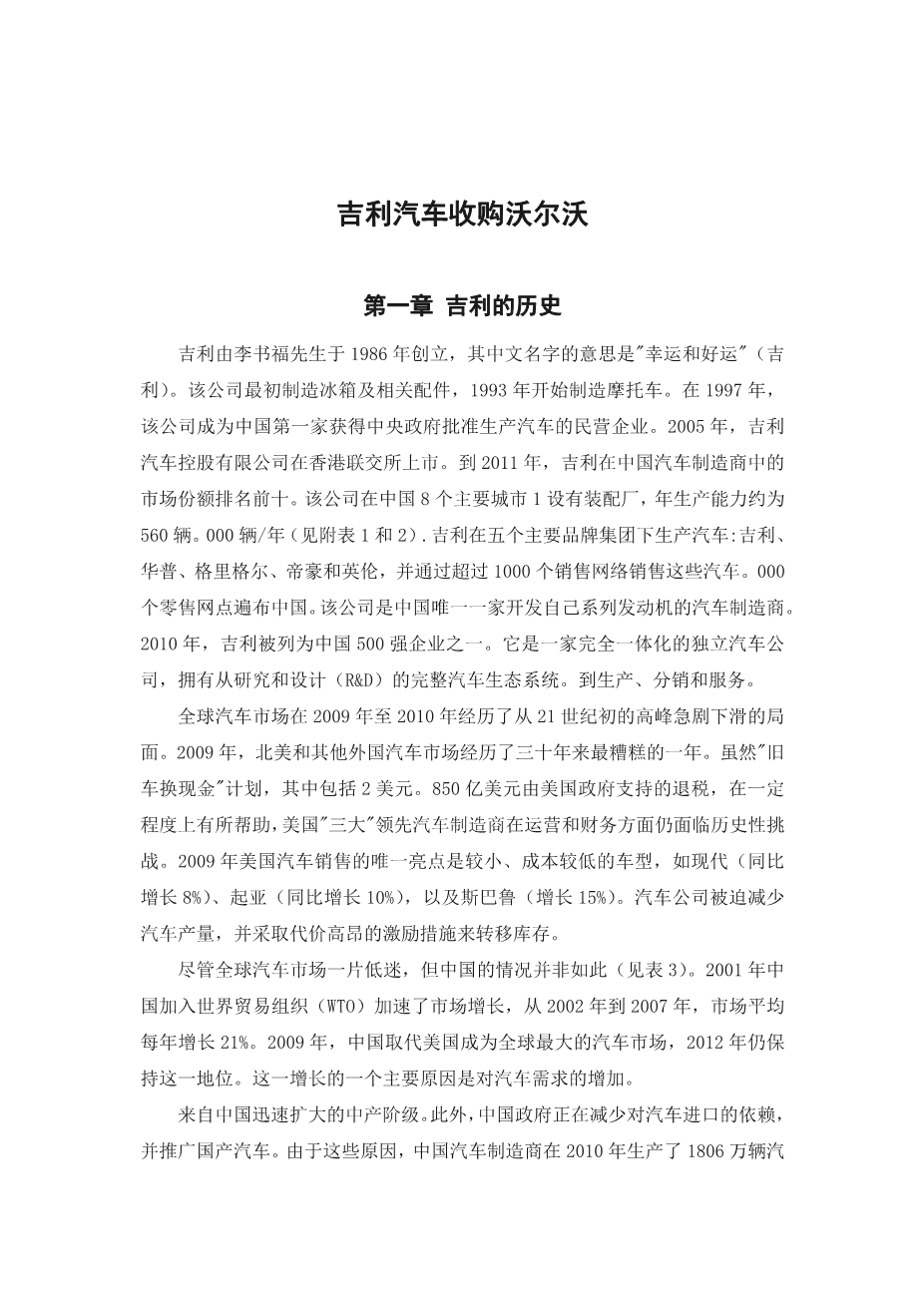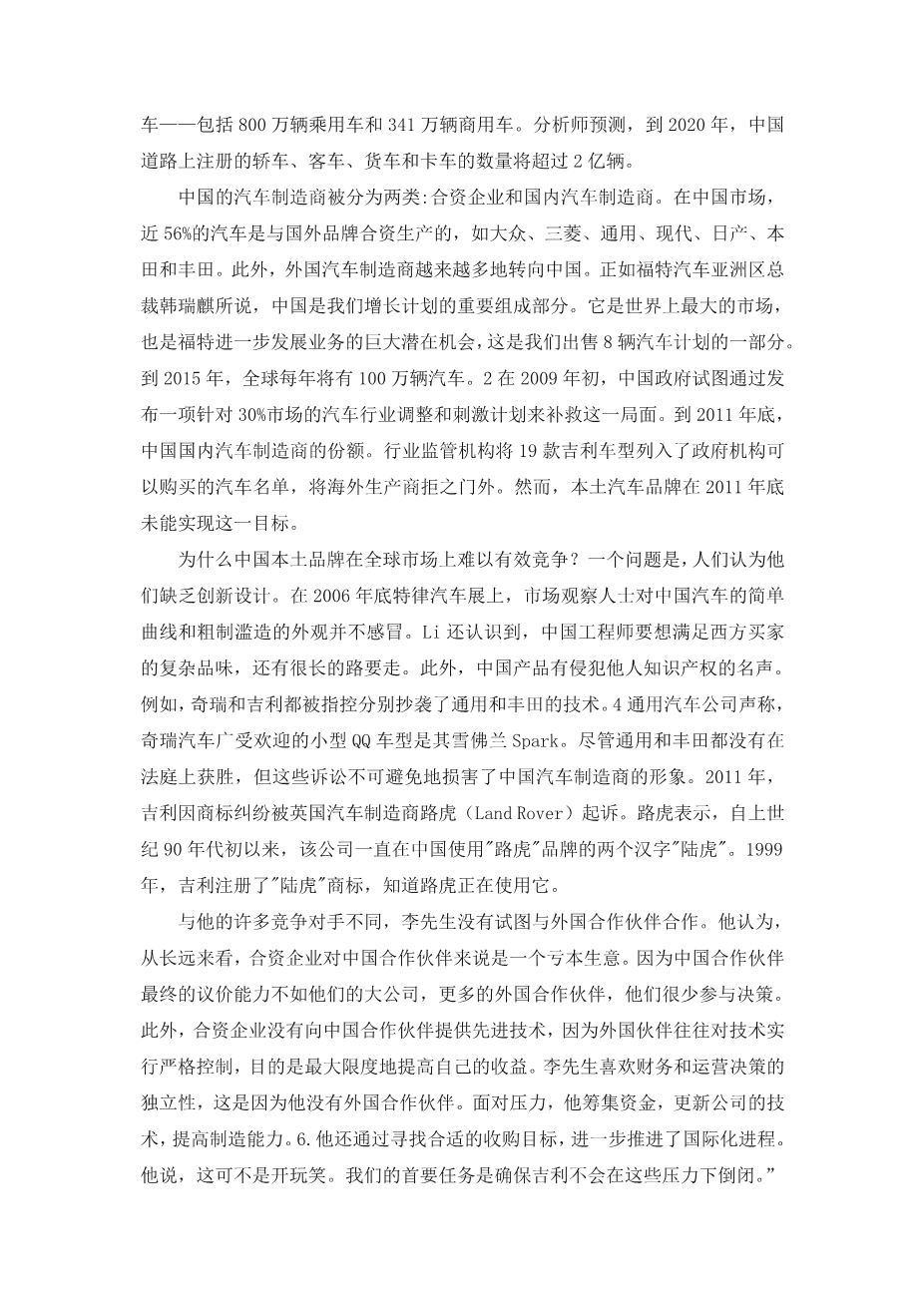Geely Automotiversquo;s Acquisition of Volvo
1 GEELYrsquo;S HISTORY
Geely, whose name denotes fortune and luck (吉利) in Chinese, was founded by Mr. Shufu Li in 1986. The company initially manufactured refrigerators and related accessories and began to manufacture motorcycles in 1993. In 1997, the company became the first private Chinese company approved by the central government to produce automobiles. In 2005, Geely Automobile Holdings Limited was listed on the Hong Kong Stock Exchange. By 2011, Geely was among the top ten carmakers in China in terms of market share, and it had assembly plants in eight major cities1 in China with a total annual production capacity of about 560,000 cars per year (see Exhibits 1 and 2). Geely produced cars under five key brand groups: Geely, Maple, Gleagle, Emgrand, and Englon and sold these cars through a network of more than 1,000 retail locations throughout China. The firm was the only Chinese carmaker to develop its own range of engines. By 2010, Geely was ranked as one of Chinarsquo;s top 500 firms. It was a fully integrated independent auto firm with a complete auto eco-system from research and design (Ramp;D) to production, distribution, and service.
THE GLOBAL AUTOMOBILE INDUSTRY
Global auto markets suffered a steep decline in 2009–2010 from the heights of the early 2000s. In 2009, North American and other foreign auto markets experienced one of their worst years in three decades. Although the “Cash for Clunkers” program, which included US$2.85 billion in US government- backed rebates, helped somewhat, the “Big Three” leading American carmakers still faced historic challenges both opera- tionally and financially. The only bright spots in US sales in 2009 were in smaller, less-costly vehicles, such as those made by Hyundai (8% increase), KIA (10% increase), and Subaru (15% increase). Car companies were forced to produce fewer vehicles and resorted to costly incentives to move inventory.
Although global auto markets were sputtering, this was not the case in China (see Exhibit 3). Chinarsquo;s entry into the World Trade Organization (WTO) in 2001 accelerated market growth, such that from 2002 to 2007 the market grew by an average of 21% a year. In 2009, China overtook the US as the largest car market, a position it still held in 2012. A major reason for this growth was the increasing demand for cars from Chinarsquo;s rapidly expanding middle class. Moreover, the Chinese government was reducing reliance on auto imports and promoting domestically manufactured cars. For these reasons, Chinese carmakers produced 18.06 million vehicles — including eight million passenger cars and 3.41 million commercial cars, in 2010. Analysts predicted that the number of registered cars, buses, vans, and trucks on the road in China would exceed 200 million units by 2020.
Chinarsquo;s carmakers were classified into two types: joint ventures and domestic carmakers. In the Chinese market, nearly 56% of the cars were produced by joint ventures with foreign brands, such as Volkswagen, Mitsubishi, General Motors, Hyundai, Nissan, Honda, and Toyota. Moreover, foreign carmakers were increasingly turning to China. As Ford Motors Asia Chief Joe Hinrichs said, “China is a big part of our growth plan. It is the largest market in the world and a great potential opportunity for Ford to grow our business even further as part of our plan to sell eight millionvehicles annually in 2015 around the world.”2 In early 2009, the Chinese government attempted to remedy this situation by releasing an Automobile Industry Adjustment and Stimulus Plan that targeted a 30% market share for Chinarsquo;s domestic car- makers by the end of 2011. The industry regulator included 19 Geely models on its list of cars that government agencies could buy, shutting out overseas producers. However, home- grown auto brands missed the target at the end of 2011 (see Exhibit 4).
Why did Chinarsquo;s domestic brands have such difficulty competing effectively in global markets? One problem was the perception that they lacked innovative designs. Market observers at the Detroit Auto Show in 2006 were unimpressed by the simple curves and shoddy finish of Chinese cars.3 Mr.Li also recognized that Chinese engineers still had a long way to go before they could satisfy the sophisticated tastes of Western buyers. Furthermore, Chinese products had a repu- tation for infringing on othersrsquo; intellectual property rights. For example, Chery and Geely were both accused of copying technology from GM and Toyota, respectively.4 GM claimed that Cheryrsquo;s popular small QQ model was a copy of its
Chevrolet Spark. Although neither GM nor Toyota prevailed in the courts, the lawsuits inevitably tarnished the image of Chinese carmakers. In 2011, Geely was sued by the British carmaker Land Rover over a trademark dispute. Land Rover said that it had been using two Chinese characters “Lu Hu” in China for its “Land Rover” brand since the early 1990s. In 1999, Geely registered the “Lu Hu” trademark, knowing that Land Rover was using it.5
Unlike many of his competitors, Mr. Li did not attempt to join with a foreign partner. He believed that joint ventures were, in the long run, a losing proposition for Chinese partners, because the Chinese partners ultimately had less bar- gaining power than their larger, more established foreign partners and they participated very little in the decision making. Furthermore, joint ventures did not provide Chinese partners with advanced technology, as foreign partners often maintained tight control over technologies with the goal of maximizing their own returns. Mr. Li liked the indepen dence in financial and operational decisions that came from remaining free of a foreign partner. Facing pressure, he raised funds to update his companyrsquo;s technology and to increase its manufacturing capacity.6 He also furthered the process of internationalization by searching for suitable acquisiti
剩余内容已隐藏,支付完成后下载完整资料


英语译文共 9 页,剩余内容已隐藏,支付完成后下载完整资料
资料编号:[607413],资料为PDF文档或Word文档,PDF文档可免费转换为Word


